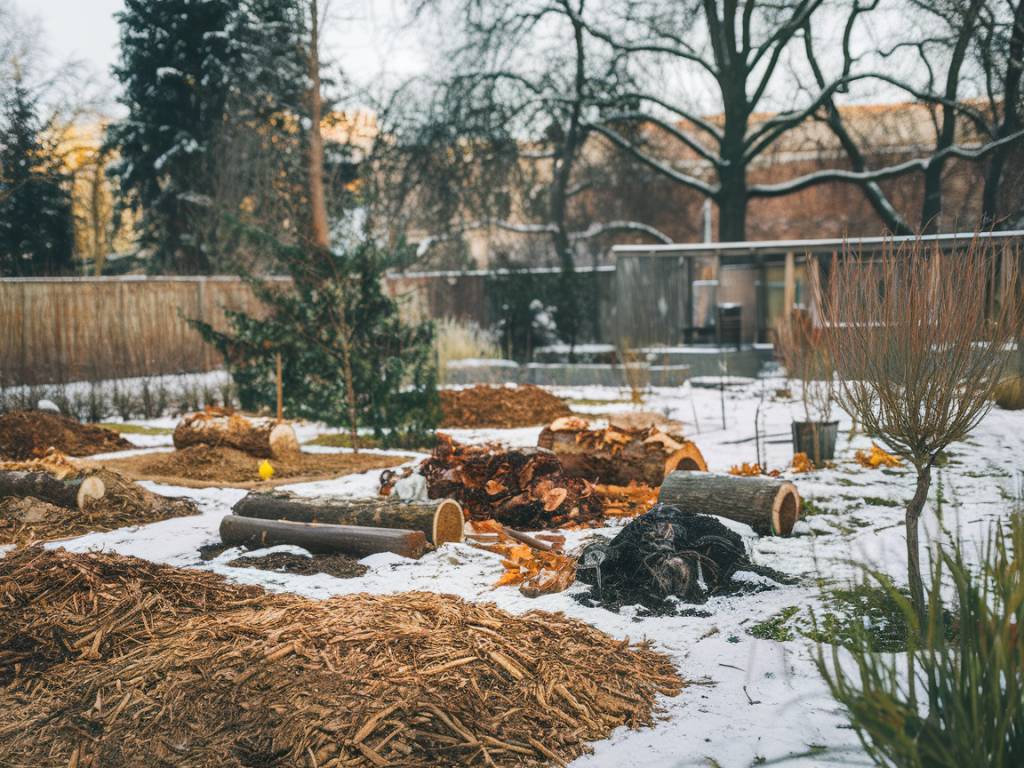Winter can be a challenging time for our gardens, but with the right soil amendments, we can ensure our plants thrive even in the chilliest months. Here are some of the best soil amendments to use during winter, all inspired by natural gardening and permaculture techniques. Let’s embrace nature’s way to keep our soil fertile and our plants robust.
Compost: The Gardener’s Black Gold
Compost is often referred to as « black gold » for a reason. It enriches the soil, improves its structure, and provides essential nutrients. During winter, I like to add a generous layer of compost to my garden beds. This not only adds organic matter to the soil but also acts as a blanket, protecting the roots of perennials and other plants from the cold. As it breaks down, compost fuels the microbial life that’s crucial for healthy soil.
If you don’t have your own compost pile, most garden centers sell high-quality compost. Just make sure to opt for organic varieties to keep your garden as natural as possible.
Leaf Mold: Nature’s Way of Recycling
Leaf mold is a fantastic soil amendment, particularly in winter. Essentially decomposed leaves, leaf mold is rich in nutrients and can help improve soil structure. It enhances the soil’s ability to retain moisture, which is particularly beneficial during the drier winter months. To make leaf mold, gather fallen leaves in the autumn and let them decompose in a corner of your garden. By winter, you should have a nutrient-rich amendment ready to use.
I typically spread leaf mold around the base of trees, shrubs, and on top of my perennial beds. It’s a simple yet highly effective way to nourish your garden naturally.
Green Manure: Winter’s Cover Crop
Planting cover crops, or green manure, is another excellent way to prepare your soil for winter. Rye, clover, and vetch are some of my favorites. These plants not only protect the soil from erosion but also add organic matter and nutrients as they decompose. Plus, they help break up compacted soil and improve its overall structure.
Sow these cover crops in late autumn. When winter comes, they’ll act as a living mulch, providing a physical barrier that helps retain soil moisture and keep the soil warmer. Then, in early spring, you can till them into the soil to add even more organic matter and nutrients.
Wood Ash: A Winter Soil Booster
If you have a wood-burning stove or fireplace, don’t throw away those ashes! Wood ash is a valuable soil amendment, especially in winter. Rich in potassium and trace elements, wood ash can help neutralize acidic soils and increase soil pH levels, making it a great addition for gardens that struggle with acidic conditions. However, it’s important to use wood ash sparingly and to avoid using it around acid-loving plants like blueberries and rhododendrons.
I usually sprinkle wood ash around the base of my vegetable beds and fruit trees. It’s an easy way to recycle waste and boost your soil’s nutrient content in the process.
Mulch: The Ultimate Insulator
Mulching is one of the best practices for winter gardening and soil health. It helps to regulate soil temperature, reduce water evaporation, and prevent weed growth. I prefer using organic mulches like straw, shredded leaves, or even bark chippings. These natural materials break down over time, adding organic matter to the soil.
Spread a thick layer of mulch around the base of plants, especially perennials and shrubs. This will provide insulation against the cold and create a more stable environment for root systems. Plus, as the mulch decomposes, it will enrich the soil naturally.
Earthworm Castings: Nature’s Fertilizer
Earthworm castings are another fantastic amendment for winter soil. Rich in nutrients, earthworm castings improve soil structure, enhance water retention, and support microbial life. Simply put, they’re a powerhouse of soil nutrition.
Adding a layer of earthworm castings to your soil in winter can help keep it fertile and ready for spring planting. I like to mix earthworm castings into my compost and spread this nutrient-rich mix over my garden beds.
Rock Dust: Trace Minerals Galore
Rock dust is a lesser-known but highly effective soil amendment. It provides a wide range of trace minerals that plants need to thrive. Unlike other amendments that break down quickly, rock dust releases its nutrients slowly, providing long-term benefits to the soil.
During winter, I scatter rock dust over my garden beds and till it lightly into the soil. It’s an excellent way to rejuvenate depleted soils and prepare them for the growing season ahead.
Coffee Grounds: A Waste Not Opportunity
Don’t toss those coffee grounds! Rich in nitrogen, coffee grounds are a wonderful soil amendment, especially during winter. They help improve soil structure and attract beneficial microbes and earthworms.
I like to sprinkle used coffee grounds around my acid-loving plants like azaleas and hydrangeas. Just be sure to mix them into the soil lightly to avoid compacting the surface. And if you’re a tea drinker, tea leaves work just as well!
Bone Meal: A Phosphorous Powerhouse
Bone meal is an excellent source of phosphorous and calcium, which are crucial for root development and overall plant health. It’s particularly beneficial for bulbs and tubers, which need strong root systems to thrive through winter and into spring.
I often add a handful of bone meal to my planting holes when putting in bulbs and spread some around established plants in late autumn. This gives them a slow-release nutrient boost that lasts throughout the colder months.
By using these natural soil amendments, you can ensure your garden remains healthy and vibrant through winter and beyond. Happy gardening!
Samanta
